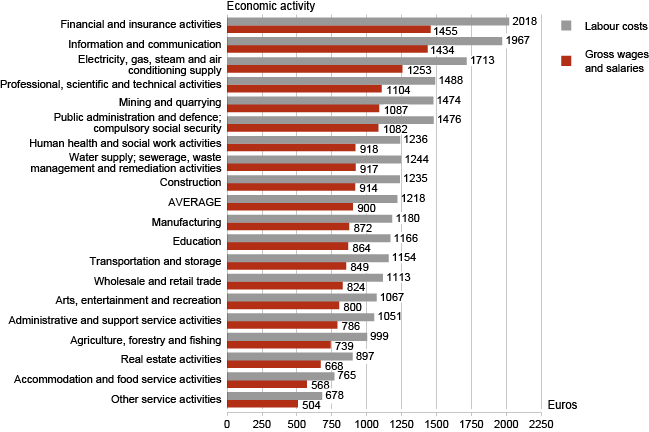The increase in wages and salaries slowed down in the 2nd quarter
Compared to the 2nd quarter of 2011, the irregular bonuses and premiums per employee grew 19.9% and influenced the growth of the average monthly gross wages and salaries by 0.4 percentage points. The average monthly gross wages and salaries without irregular bonuses and premiums increased 4.6%.
Compared to the same quarter of 2011, the growth of the average gross monthly wages and salaries in the 2nd quarter of 2012 was smaller than in the previous quarters (6.3% growth in the 4th quarter; 6.9% growth in the 1st quarter).
Real wages, which take into account the influence of the change in the consumer price index and which show the purchasing power of wages and salaries, increased 1.1% in the 2nd quarter of 2012. Compared to the same quarter of the previous year, real wages increased for the fourth quarter in succession, but the growth was lower than in the previous quarters (2.1% in the 4th quarter; 2.4% in the 1st quarter).
The average hourly gross wages and salaries were 5.28 euros and increased by 3.9% compared to the 2nd quarter of the previous year.
According to the Wages and Salaries Statistics Survey, the number of employees as at the end of June had increased by 3.8% compared to the same period of 2011.
Compared to the 2nd quarter of 2011, the average monthly and hourly gross wages and salaries increased the most in arts, entertainment and recreation (13.4% and 10.9% respectively).
Compared to the 2nd quarter of 2011, the average monthly gross wages and salaries decreased only in mining and quarrying (1.0%) and the average hourly gross wages and salaries decreased the most in financial and insurance activities (1.6%).
The average gross wages and salaries were 874 euros in April, 878 euros in May and 948 euros in June.
In the 2nd quarter of 2012, the employer’s average monthly labour costs per employee were 1,218 euros and the average hourly labour costs were 8.00 euros. Compared to the 2nd quarter of 2011, the average monthly labour costs per employee increased by 5.1% and the average hourly labour costs by 3.2%.
Compared to the 2nd quarter of 2011, the average monthly and hourly labour costs per employee increased the most in construction (12.2% and 9.0% respectively).
Compared to the 2nd quarter of 2011, the average monthly labour costs per employee decreased only in mining and quarrying (1.1%) and the average hourly labour costs per employee decreased only in financial and insurance activities (1.3%).
Statistics Estonia conducts the Wages and Salaries Statistics Survey on the basis of international methodology since 1992. In 2012, the sample includes 11,523 enterprises, institutions and organisations. The average monthly gross wages and salaries have been given in full time units to enable a comparison of different wages and salaries, irrespective of the length of working time. Calculations of the monthly gross wages and salaries are based on payments for actually worked time and remuneration for time not worked. The hourly gross wages and salaries do not include remuneration for time not worked (holiday leave pay, benefits, etc.). In short-term statistics, the average gross wages and salaries are measured as a component of labour costs. Labour costs include gross wages and salaries, employer’s contributions and employer’s imputed social contributions to employees.
| Year | 1st quarter | 2nd quarter | 3rd quarter | 4th quarter | |
|---|---|---|---|---|---|
| 2008 | 825 | 788 | 850 | 800 | 838 |
| 2009 | 784 | 776 | 813 | 752 | 783 |
| 2010 | 792 | 758 | 822 | 759 | 814 |
| 2011 | 839 | 792 | 857 | 809 | 865 |
| 2012 | 847 | 900 |
Average monthly gross wages and salaries, 1st quarter 2008 – 2nd quarter 2012 (euros)
Average hourly gross wages and salaries and hourly labour costs, 2nd quarter 2012

